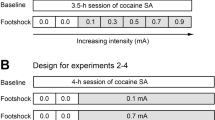Abstract
Although numerous animal procedures have been employed in the study of generalized anxiety and agents effective in treating generalized anxiety, an analogous “behavioral model” for the study of panic disorder does not exist. In the present study, the effects of imipramine were examined in a potential “animal model” for panic disorder, the conditioned suppression of drinking (CSD) paradigm. In daily 10-min sessions, water-deprived rats were trained to drink from a tube that was occasionally electrified (0.5 mA). Electrification was signalled by a tone. Imipramine was administered both in an acute (3.5–20 mg/kg, IP) and a chronic (2.5 mg/kg, IP, twice daily for 5 weeks) regimen. Acute administration of imipramine resulted in a decrease in the number of shocks accepted and a decrease in water intake. In contrast, chronic administration of imipramine resulted in a gradual increase in the number of shocks received in CSD sessions over the course of several weeks of testing. This time-dependent increase in punished responding in the CSD observed during chronic imipramine treatment parallels the time-dependent reduction in the severity and frequency of panic attacks in panic disorder patients receiving chronic imipramine. Thus, the CSD paradigm might serve as an “animal model” for the study of panic disorder and potential anti-panic agents.
Similar content being viewed by others
References
Beaudry P, Fontaine R, Chouinard G, Annable L (1986) Clonazepam in the treatment of patients with recurrent panic attacks. J Clin Psychiatry 74(2):83–85
Cassella JV, Davis M (1985) Fear-enhanced acoustic startle is not attenuated by acute or chronic imipramine treatment in rats. Psychopharmacology 87(3):278–282
Chouinard G, Annable L, Fontaine R, Solyom L (1982) Alprazolam in the treatment of generalized anxiety and panic disorders: A double-blind placebo-controlled study. Psychopharmacology 77:229–233
Commissaris RL, Rech RH (1982) Interactions of metergoline with diazepam, quipazine and hallucinogenic drugs on a conflict behavior in the rat. Psychopharmacology 76:282–285
Commissaris RL, Harrington GH, Ortiz AM, Altman HJ (1986) Maudsley reactive and non-reactive rat strains: Differential performance in a conflict task. Physiol Behav 38:291–294
Diagnostic and Statistical Manual of Mental Disorders (1980) 3rd edn, Washington, DC, Am Psychiatr Assoc
File SE, Pellos S, Chapin P (1985) Can animal tests of anxiety detect anti-panic compounds? Neurosci Abstr 11:273
Ford RD, Rech RH, Commissaris RL, Mayer L (1979) Effects of acute and chronic interactions of diazepam and d-amphetamine on punished and unpunished behavior of rats. Psychopharmacology 65:197–204
Garakani H, Zitrin CH, Klein DF (1984) Treatment of panic disorder with imipramine alone. Am J Psychiatry 141:446–448
Geller I (1964) Relative potencies of benzodiazepines as measured by their effects on conflict behavior. Arch Int Pharmacodyn Ther 149:243–247
Geller I, Seifter J (1960) The effects of meprobamate, barbiturates, d-amphetamine and promazine on experimentally induced conflict in the rat. Psychopharmacology 1:482–492
Geller I, Kulak JT, Seifter J (1962) Attenuation by chlordiazepoxide and chlorpromazine on a punished discrimination. Psychopharmacology 3:374–385
Harvey SC (1985) Hypnotics and sedatives. In: Goodman Gilman S, Goodman LS, Rall TW, Murad F (eds) Goodman and Gilman's the pharmacological basis of therapeutics. Macmillan, New York, pp 339–371
Kahn RJ, McNair DM, Lipman RS, Covi L, Rickels K, Downing R, Fisher S, Frankenthaler LM (1986) Imipramine and chloridiazepoxide in depressive and anxiety disorders: 2. Efficacy in anxious outpatients. Arch Gen Psychiatry 43:79–85
Kilts CD, Commissaris RL, Rech RH (1981) Comparison of anti-conflict drug effects in three experimental models of anxiety. Psychopharmacology 74:290–296
Klein DF (1964) Delineation on two drug-responsive anxiety syndromes. Psychopharmacology 5:397–408
Klein DF (1967) Importance of psychiatric diagnosis in prediction of clinical drug effects. Arch Gen Psychiatry 16:118–126
Klein DF, Gittleman R, Quitkin F, Rifkin A (1980) Diagnosis and drug treatment of psychiatric disorders: adults and children, 2nd edn. Williams and Wilkins, Baltimore
Mavissakalian M, Michelson L, Dealy RS (1983) Pharmacological treatment of agoraphobia: imipramine versus imipramine with programmed practice. Br J Psychiatry 143:348–355
McCloskey TC, Paul BK, Commissaris RL (1987) Buspirone effects in an animal conflict procedure: comparison with diazepam and phenobarbital. Pharmacol Biochem Behav 27:171–175
McNair DM, Kahn RK (1981) Imipramine compared with a benzodiazepine for agrophobia. In: Klein DF, Rabkin G (eds) Anxiety: new research and changing concepts. Raven Press, New York, pp 69–80
Noyes R, Anderson DJ, Clancy J, Crowe RR (1984) Diazepam and propranolol in panic disorder and agoraphobia. Arch Gen Psychiatry 41:287–292
Pollack MH, Tesar GE, Rosenbaum JF, Spier SA (1986) Clonazepam in the treatment of panic disorder with agoraphobia: a one-year follow-up. J Clin Psychopharmacol 6:303–304
Sheehan DV (1986) The tricyclic antidepressants in the treatment of panic and anxiety disorders. Psychosomatics 27(11):10–16
Sheehan DV, Sheehan KH (1987) Pharmacological treatment of panic and anxiety disorders. ISI Atlas of Science. Pharmacology 1:254–256
Sheehan DV, Ballanger J, Jacobsen G (1980) Treatment of endogenous anxiety with phobic, hysterical, and hypocondriacal symptoms. Arch Gen Psychiatry 37:51–59
Spier SA, Rosenbaum JF, Woods SW (1986) Treatment of panic disorder and agoraphobia with clonazepam. J Clin Psychiatry 47:238–243
Steele RGD, Torrie JH (1985) Principles and procedures of statistics. McGraw-Hill, New York
Tyrer P (1986) Classification of anxiety disorders: a critique of DSM-III. J Affective Disord 11(2):99–104
Vogel JR, Beer B, Clody DE (1971) A simple and reliable conflict procedure for testing antianxiety agents. Psychopharmacologia 21:1–7
Zitrin C, Klein DF, Woerner M (1980) Treatment of agoraphobia with group exposure in vivo and imipramine. Arch Gen Psychiatry 37:62–72
Author information
Authors and Affiliations
Rights and permissions
About this article
Cite this article
Fontana, D.J., Commissaris, R.L. Effects of acute and chronic imipramine administration on conflict behavior in the rat: a potential “animal model” for the study of panic disorder?. Psychopharmacology 95, 147–150 (1988). https://doi.org/10.1007/BF00174499
Received:
Revised:
Issue Date:
DOI: https://doi.org/10.1007/BF00174499




